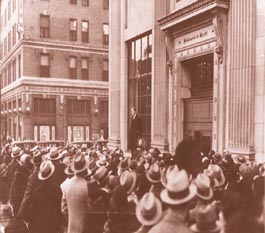I s my money safe? That seems to be the question many Americans are asking in the face of the nation’s worst economic crisis since the Great Depression. As news of the collapse of financial institutions dominates websites, newspapers and television news, the average American may be feeling a bit uneasy about the security of their hard earned dollars in their bank accounts. For the most part, you can rest assured that your money is fine.
s my money safe? That seems to be the question many Americans are asking in the face of the nation’s worst economic crisis since the Great Depression. As news of the collapse of financial institutions dominates websites, newspapers and television news, the average American may be feeling a bit uneasy about the security of their hard earned dollars in their bank accounts. For the most part, you can rest assured that your money is fine.
One of the positive consequences of the big crash of ’29 was a federal regulatory system to insure that deposits were protected in the event of a bank’s collapse. The Federal Deposit Insurance Corporation (FDIC) was created in 1933 as a result of the wave of bank failures in the 1920’s and 1930’s. It was established by the Banking Act of 1933, signed into law by President Franklin Delano Roosevelt on June 16, 1933.
Savings, checking and other deposits are generally insured up to $100,000 per depositor in each bank or thrift that the FDIC insures. Also, deposits held in different categories of ownership – single or joint accounts – may be insured separately. The FDIC also offers protection for retirement accounts such as individual retirement accounts (IRA’s) or Keoghs, up to $250,000. Amazingly, since the start of FDIC insurance no depositor has ever lost cent of insured funds.
The FDIC is an independent agency of the federal government but is does not receive a Congressional appropriation. It is governed by a five person Board of Directors, appointed by the President and confirmed by the U.S. Senate. The board meets once a month. The agency is funded by premiums that bank and thrifts pay for deposit insurance coverage and from earnings in investments in U.S. Treasury securities. The agency directly oversees some 5,250 banks and savings banks across the country, about half of all banking institutions. The term “insured bank” means a bank that is insured by the FDIC, including banks charted by the federal government and most banks chartered by state governments. An insured bank must display the FDIC sign at the window of each teller. The FDIC has funds totaling $49 billion and insures about $3 trillion of deposits. The agency does not insure securities, mutual funds or similar types of investments a bank may offer.
When a bank or savings institution fails, it is usually closed by its chartering authority; either a state regulator, the Office of the Comptroller of the Currency, or the Office of Thrift Supervision. Upon a bank’s collapse the FDIC has several courses it can take. Generally, the agency most often sells the deposits and loans of the failed institution to another institution. Customers of the failed institution automatically become customers of the new institution.
FDIC insurance covers the balance of each depositor’s account, dollar for dollar, up to the insurance limit, including principal and any accrued interest through the date of the insured bank’s closing.
So the answer to the question originally posed - Is my Money Safe? – is yes, with certain conditions. Should you have any concerns about your deposits you should consult with your bank.
Despite the rash of bad news, most banks in the country are doing well and there is little danger of the type of widespread panic that resulted when the stock market crashed in 1929. Today, federal oversight and regulation, nonexistent in the early 1900’s provides a layer of protection for the average depositor.
The following are some frequently asked questions and answers provided by the FDIC:
Who does the FDIC insure?
Any person or entity can have FDIC insurance on a deposit. A depositor does not have to be a citizen, or even a resident of the United States. FDIC insurance only protects depositors, although some depositors may also be creditors or shareholders of an insured bank.
What does FDIC deposit insurance cover?
FDIC insurance covers deposits received at an insured bank. Types of deposit products include checking, NOW, and savings accounts, money market deposit accounts (MMDA), and time deposits such as certificates of deposit (CDs).
What is the source of funding used by the FDIC to pay insured depositors of a failed bank?
The FDIC’s deposit insurance fund consists of premiums already paid by insured banks and interest earnings on its investment portfolio of U.S. Treasury securities. No federal or state tax revenues are involved.
How am I notified when my bank has been closed?
The FDIC notifies each depositor in writing using the depositor's address on record with the bank. This notification is mailed immediately after the bank closes.
When the failed bank is acquired by another bank; the assuming bank also notifies the depositors. This notification usually is mailed with the first bank statement after the assumption.
Every effort also is made to inform the public through the news media, town meetings, and notices posted at the bank.

today in black history
January 04, 2025
Dr. Melvin H. Evans becomes the first elected Governor of the Virgin Islands in 1971.
Is My Money Safe?
POSTED: September 21, 2008, 12:00 pm











